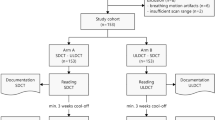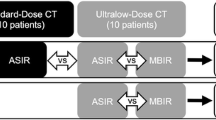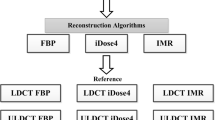Abstract
Purpose
To evaluate the effect of dose reduction with iterative reconstruction (IR) on image quality of chest CT scan comparing two protocols.
Materials and methods
Fifty-nine patients were enrolled. The two CT protocols were applied using Iterative Reconstruction (ASIR™) 40% but different noise indexes, recording dose-length product (DLP) and volume computed tomography dose index (CTDIvol). The subjective IQ was rated based on the distinction of anatomic details using a 4-point Likert scale based on the European Guidelines on Quality Criteria for CT. For each patient, two single CTs, at enrollment (group 1) and at follow-up after lowering the dose (group 2), were evaluated by two radiologists evaluating, for each examination, five different lung regions (central zone—CZ; peripheral zone—PZ; sub-pleural region—SPR; centrilobular region—CLR; and apical zone—AZ). An inter-observer agreement was expressed by weighted Cohen’s kappa statistics (k) and intra-individual differences of subjective image analysis through visual grading characteristic (VGC) analysis.
Results
An average 50.4% reduction in CTDIvol and 51.5% reduction in DLP delivered were observed using the dose-reduced protocol. An agreement between observers evaluating group 1 CTs was perfect (100%) and moderate to good in group 2 examinations (k-Cohen ranging from 0.56 for PZ and AZ to 0.70 for SPR). In the VGC analysis, image quality ratings were significantly better for group 1 than group 2 scans for all regions (AUCVGC ranging from 0.56 for CZ to 0.62). However, disagreement was limited to a score 4 (excellent)-to-score 3 (good) IQ transition; apart from a single case in PZ, both the observers scored the IQ at follow-up as 2 (sufficient) starting from a score 4 (excellent).
Conclusion
Dose reduction achieved in the follow-up CT scans, although a lower IQ still allows a good diagnostic confidence.




Similar content being viewed by others
References
Regulla DF, Eder H (2005) Patient exposure in medical X-ray imaging in Europe. Radiat Prot Dosim 114:11–25
Brenner DJ, Hall EJ (2007) Computed tomography—an increasing source of radiation exposure. N Engl J Med 357:2277–2284
Scanff P, Donadieu J, Pirard P, Aubert B (2008) Population exposure to ionizing radiation from medical examinations in France. Br J Radiol 81:204–213
Hansen J, Jurik AG (2009) Analysis of current practice of CT examinations. Acta Oncol (Madr) 48:295–301
United Nations Scientific Committee on the Effects of Atomic Radiation (UNSCEAR) (2000) Sources and effects of ionizing radiation. United Nations, New York, NY, p 2000
Catuzzo P, Aimonetto S, Zenone F et al (2010) Population exposure to ionising radiation from CT examinations in Aosta Valley between 2001 and 2008. Br J Radiol 83:1042–1051
Mettler FA, Bhargavan M, Faulkner K et al (2009) Radiologic and nuclear medicine studies in the United States and worldwide: frequency, radiation dose, and comparison with other radiation sources—1950–2007. Radiology 253:520–531
National researcher Council (2006) Health risks from exposure to low levels of ionizing radiation: BEIR VII. National Academic Press, Washington D
Brenner DJ, Shuryak I, Einstein AJ (2011) Impact of reduced patient life expectancy on potential cancer risks from radiologic imaging. Radiology 261:193–198
O’Connor MK (2017) Risk of low-dose radiation and the BEIR VII report: a critical review of what it does and doesn’t say. Phys Med 43:153–158
Miglioretti DL, Johnson E, Williams A et al (2013) The use of computed tomography in pediatrics and the associated radiation exposure and estimated cancer risk. JAMA Pediatr 167:700–707
Bernier MO, Baysson H, Pearce MS, Moissonnier M, Cardis E, Hauptmann M et al (2019) Cohort Profile: the EPI-CT study: a European pooled epidemiological study to quantify the risk of radiation-induced cancer from paediatric CT. Int J Epidemiol 48:379–381
Meleupas JM, Ronckers CM, Smets AMJB, Nievelstein RAJ, Gradowska P, Lee C et al (2019) Radiation exposure from pediatric CT scans and subsequent cancer risk in the Netherlands. J Natl Cancer Inst 111:256–263
Kalra MK, Maher MM, Toth TL et al (2004) Strategies for CT radiation dose optimization. Radiology 230:619–628
Mettler FA Jr, Wiest PW, Locken JAKC (2000) CT scanning: patterns of use and dose. J Radiol Prot 20:535–539
McCollough CH, Primak AN, Braun N et al (2009) Strategies for reducing radiation dose in CT. Radiol Clin North Am 47:27–40
Raman SP, Johnson PT, Deshmukh S et al (2013) CT dose reduction applications: available tools on the latest generation of CT scanners. J Am Coll Radiol 10:37–41
Lumbreras B, Salinas JM, Gonzalez-Alvarez I (2019) Cumulative exposure to ionising radiation from diagnostic imaging tests: a 12-year follow-up population-based analysis in Spain. BMJ Open 9:e030905
Salerno S, Marrale M, Geraci C, Caruso G, Lo Re G, Lo Casto A, Midiri M (2006) Cumulative doses analysis in young trauma patients: a single-centre experience. Radiol Med 121:144–152
Yu L, Vrieze TJ, Leng S et al (2015) Technical note: measuring contrast- and noise-dependent spatial resolution of an iterative reconstruction method in CT using ensemble averaging. Med Phys 42:2261–2267
Katsura M, Sato J, Akahane M et al (2017) Effects of pure and hybrid iterative reconstruction algorithms on high-resolution computed tomography in the evaluation of interstitial lung disease. Eur J Radiol 93:243–251
Laqmani A, Buhk JH, Henes FO et al (2013) Impact of a 4th generation iterative reconstruction technique on image quality in low-dose computed tomography of the chest in immunocompromised patients. Rofo 185:749–757
McCollough CH, Yu L, Kofler JM et al (2015) Degradation of CT low-contrast spatial resolution due to the use of iterative reconstruction and reduced dose levels. Radiology 276:499–506
Zwirewich CV, Mayo JR, Müller NL (1991) Low-dose high-resolution CT of lung parenchyma. Radiology 180:413–417
Christe A, Charimo-Torrente J, Roychoudhury K et al (2013) Accuracy of low-dose computed tomography (CT) for detecting and characterizing the most common CT-patterns of pulmonary disease. Eur J Radiol 82:e142–e150
Subcommittee on Appropriateness Criteria Radiation Exposure, Jordan DW, Becker MD, Brady S et al (2019) Validation of adult relative radiation levels using the ACR dose index registry: report of the ACR appropriateness criteria radiation exposure subcommittee. J Am Coll Radiol 16:236–239
Bongartz G, Golding SJ, Jurik AG et al (2004) for the European Commission. European Guidelines for Quality Criteria for Computed Tomography. EUR 16262 EN. Luxembourg: European Commission. http://www.drs.dk/guidelines/ct/quality/htmlindex.htm. Accessed Apr 2019
Landis JR, Koch GG (1977) The measurement of observer agreement for categorical data. Biometrics 33:159–174
Cohen J (1968) Weighed kappa: nominal scale agreement with provision for scaled disagreement or partial credit. Psychol Bull 70:213–220
Båth M, Månsson LG (2007) Visual grading characteristics (VGC) analysis: a non-parametric rank-invariant statistical method for image quality evaluation. Br J Radiol 80:169–176
Burmeister HP, Baltzer PAT, Möslein C et al (2011) Visual grading characteristics (VGC) analysis of diagnostic image quality for high resolution 3 Tesla MRI volumetry of the olfactory bulb. Acad Radiol 18:634–639
Jensen K, Andersen HK, Smedby Ö et al (2018) Quantitative measurements versus receiver operating characteristics and visual grading regression in CT images reconstructed with iterative reconstruction: a phantom study. Acad Radiol 25:509–518
Hanley JA, McNeil BJ (1982) The meaning and use of the area under a receiver operating characteristic (ROC) curve. Radiology 143:29–36
Båth M, Hansson J (2016) VGC Analyzer: a software for statistical analysis of fully crossed multiple-reader multiple-case visual grading characteristics studies. Radiat Prot Dosim 169:46–53
Tang H, Yu N, Jia Y et al (2018) Assessment of noise reduction potential and image quality improvement of a new generation adaptive statistical iterative reconstruction (ASIR-V) in chest CT. Br J Radiol 91:20170521
Tang S, Liu X, He L et al (2019) Application of ASiR in combination with noise index in the chest CT examination of preschool-age children. Radiol Med 124:467–477
Author information
Authors and Affiliations
Corresponding author
Ethics declarations
Conflict of interest
All the authors are aware of the content of the manuscript and have no conflict of interest associated with this study.
Ethical standards
All procedures performed in studies involving human participants were in accordance with the ethical standards of the institutional and/or national research committee and with the 1964 Declaration of Helsinki and its later amendments or comparable ethical standards.
Informed consent
This study was approved by the local ethical board, and the informed consensus was obtained from all individual participants included in the study.
Additional information
Publisher's Note
Springer Nature remains neutral with regard to jurisdictional claims in published maps and institutional affiliations.
Rights and permissions
About this article
Cite this article
Cristofaro, M., Busi Rizzi, E., Piselli, P. et al. Image quality and radiation dose reduction in chest CT in pulmonary infection. Radiol med 125, 451–460 (2020). https://doi.org/10.1007/s11547-020-01139-5
Received:
Accepted:
Published:
Issue Date:
DOI: https://doi.org/10.1007/s11547-020-01139-5




